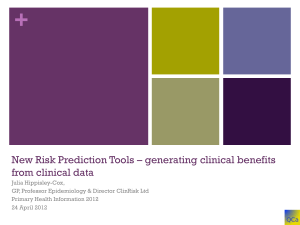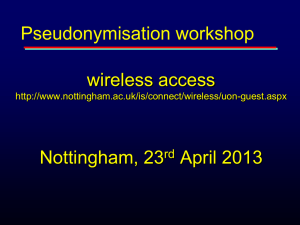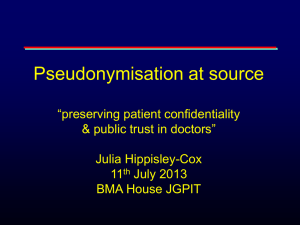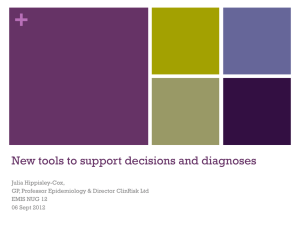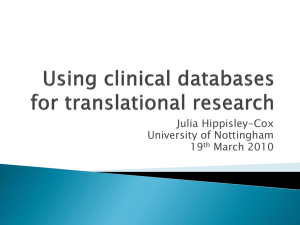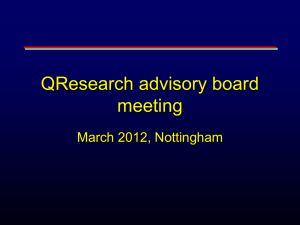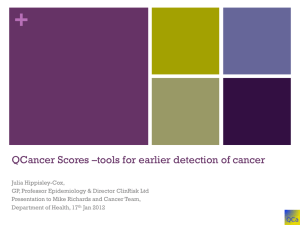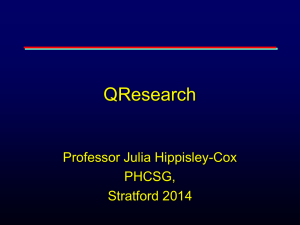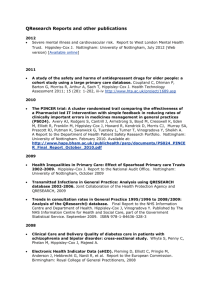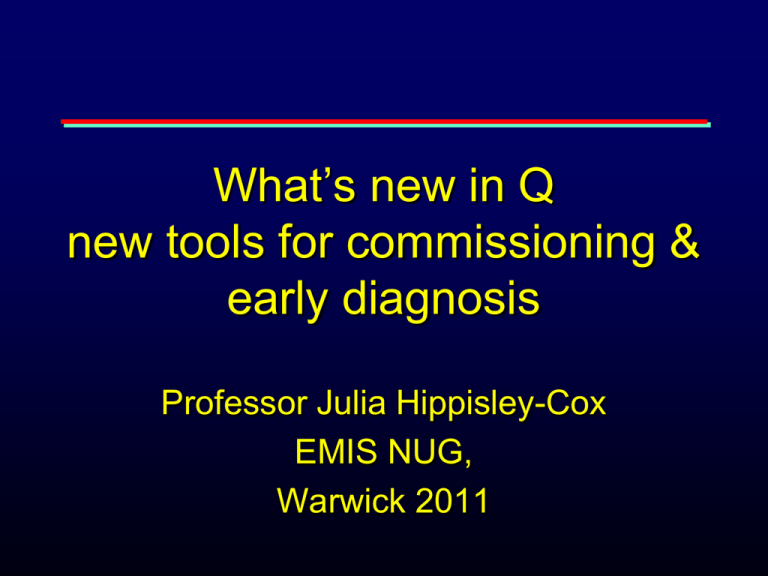
What’s new in Q
new tools for commissioning &
early diagnosis
Professor Julia Hippisley-Cox
EMIS NUG,
Warwick 2011
Acknowledgements
•
•
•
•
•
•
•
Contributing practices
EMIS NUG (Chris, Charlie + others)
EMIS (Sean, David, Andy, Shaun+ others)
University of Nottingham
QResearch Advisory Board
ClinRisk (software)
Co-authors/researchers
Overview
•
•
•
•
•
QFeedback
QData Linkage Project
Risk stratification tools for commissioning
QCancer – assess risk of existing cancer
Questions/Discussion/Suggestions
Get switched on
See the invitation in your
delegate bag
ideally all practices to
contribute to both
QResearch &
QSurveillance
Email julia.hippisleycox@nottingham.ac.uk
QFeedback
QFeedback: update
• Interactive tool based on QSurveillance
• Allows practices to view own data compared
• PCT, SHA, UK
• Similar practices
•
•
•
•
Graphs, Maps, Export data to excel
Deployed to 3,400 EMIS LV in early 2011
Uptake 2885 practices in 1st 6 months
Final of E Heath innovation awards
QFeedback in LV
QFeedback dashboard
Example maps
QResearch Data
Linkage Project
QResearch Data
Linkage Project
• QResearch database already linked to
• deprivation data
• cause of death data
• Very useful for research
• better definition & capture of outcomes
• Health inequality analysis
• Improved performance of QRISK and similar
scores
QResearch Linkage Project
Data source
Content
• Cancer registry
• Cancer type, grade stage
• MINAP ‘Myocardial
Infarction National Audit
Project’
• Heart attack type and
treatment
New approach
pseudonymisation
• Need approach which doesn’t extract
identifiable data but still allows linkage
•
•
•
•
•
•
Legal, ethical and NIGB approvals
Secure, Scalable
Reliable, Affordable
Generates ID which are Unique to Project
Applied within the heart of the clinical system
Minimise disclosure
Pseudonymisation: method
• Scrambles NHS number BEFORE extraction
from clinical system
• Takes NHS number + project specific encrypted
‘salt code’
• One way hashing algorithm (SHA2-256)
• Cant be reversed engineered
• Applied twice in to separate locations before data
leaves EMIS
• Apply identical software to external dataset
• Allows two pseudonymised datasets to be linked
QScores – risk prediction tools
QScores – family of
Risk prediction tools
• Population level
• Risk stratification
• Identification of rank ordered list of patients for
recall or reassurance
• Individual assessment
• Who is most at risk of preventable disease?
• Who is likely to benefit from interventions?
• What is the balance of risks and benefits for my
patient?
• Enable informed consent and shared decisions
Criteria for chosing clinical
outcomes
•
•
•
•
•
•
Major cause morbidity & mortality
Represents real clinical need
Related intervention which can be targeted
Related to national priorities (ideally)
Necessary data in clinical record
All then available as Open Source software
QScores: summary 1
Outcome
Intervention
tool
NHS/NICE
qrisk.org
NHS Health
Checks
QOF
NICE
(CG67)
NHS Health
Checks
10 yr risk
Cardiovascular
disease (2008)
smoking cessation;
weight loss;
BP control
lipid control
10 yr risk
Type 2 diabetes
(2009)
Exclude undiagnosed
qdscore.org
diabetes
Weight loss
Exercise
medication
Lifestyle measures
qkidney.org
avoid nephrotoxic drugs
Lower BP
more frequent follow up of
kidney function to allow
earlier referral.
5 yr risk moderate
or severe Chronic
kidney failure
(2010)
NHS Health
Checks
QScores: summary 2
Outcome
Adverse effects of
statins
Myopathy
Acute renal failure
Serious liver
dysfunction
Osteoporotic fracture
Hip/spine/wrist
(2009)
Intervention
tool
NHS/NICE
Review of dose as effects
qintervention.org NICE (CG67)
increase with dose
Increased monitoring of U&E,
LFT and CK for high risk
regular weight bearing
exercise
Stop smoking, reduce alcohol
Diet – vitamin D and calcium
Reduce risk of falling ;
Check eye sight;
medication review (eg
antihypertensives, tricyclics)
Hip protectors
Vitamin d3 and calcium
Bisphophonates
qfracture.org
NICE draft
osteoporosis
& fragility risk
Pilot for QOF
QScores: summary 3
Outcome
Venous
thromboembolism
(2011)
•Age, sex, BMI
•Smoking
•Varicose veins
•Chronic renal disease
•Heart failure
•COPD
•IBS
•Hospital admission
•Antipsychotics
•HRT
•COP
•Tamoxifen
Intervention
Prophylaxis/anticoagulation
Eg on hospital admission
review of medication which
increases risk (COP, HRT,
antipsychotics, tamoxifen)
tool
NHS/NICE
qthrombosis.org Related to
NICE (CG92)
Population risk stratification
for PCTs/CG
•
•
•
•
Possible to apply all algorithms at PCT level
view the risk profile of population,
estimate the likely burden of disease
model the costs and benefits of interventions at
different thresholds of risk
• set local targets
• determine search strategies which the practice or
community staff can use for call/recall
• evaluate outcomes & reset priorities.
Risk Stratification: questions
• QRISK & QDScore now being used at PCT
level for recall
1. How useful has QRISK been for PCTs/practices
2. Useful to do this for other existing QScores?
3. Suggestions for new outcomes which would be
useful
• at PCT level?
• at patient level?
Risk of Hospital Admission
• Requests from PCTs/CG to develop new tool
identify patients
• At risk of hospital admission
• At risk of re-admission
• Problems with PARR ++ and the Combined
Tool
• Never properly validated
• Difficult to implement
• Not been updated
QAdmission (QA) Score
shall we do it?
• Utility
• To identify patients high risk (re) admission
• Intervention
• Virtual wards
• Community matrons
• Implementation
• Needs to be simpler to implement
• Integrated into any clinical system
• Regularly updated coefficients
QCancer
Tools to help earlier diagnosis
www.qcancer.org
Username: nuguser
Password: ATouchOfSpice
Cancer:
The problem of diagnosis
• Some cancers diagnosed very late when
curative Rx not possible
• Symptoms very common in general practice
• Single symptoms not very specific
• Earlier diagnosis improves options & outcome
• NICE guidelines
• Complicated
• Miss patients & false positive
• No indication of risk of patient having cancer
Key predictive
symptoms & factors
•
•
•
•
•
•
•
•
•
•
Loss weight/appetite
Rectal bleeding
Haematemesis
Dysphagia
Haemoptysis
Haematuria
PMB
Abdominal pain
Constipation/diarrhoea
Cough
•
•
•
•
•
•
•
•
Age, sex, ethnicity
deprivation
Smoking
Alcohol
Family history
Chronic diseases
Prior cancers
Anaemia (Hb<11)
Six common cancers so far
•
•
•
•
•
•
Lung cancer
Colorectal cancer
Gastro-oesophageal cancer
Pancreatic cancer
Ovarian cancer
Renal cancer
New approach needed
• Need information based on patients record
• combines symptoms + patient characteristics
(age, sex, deprivation, PMH, FH)
• Absolute risk of different type of cancer
• Needs to be available WITHIN the consultation to
guide management
• Also as batch processing to identify patients with
alarm symptoms/high risk but no investigations or
outcome BEFORE or AFTER consultation
QCancer methods
• Used 2/3 sample of QResearch database
• Identified all patients with new onset alarm
symptoms in last 10 years
• Followed up over 2 yr for diagnoses of cancer
• Developed set of models which incorporates
symptoms and profile to give risk calculation
• Tested performance of models on rest of
QResearch database & THIN database (INPS)
• External validation by Oxford academics
• Publication due Winter 2011/12
Using QCancer in practices
demo
• www.qcancer.org
• Either use as standalone or integrated
• Template to help better recording positive and
negative symptoms triggered by code for alarm
symptom?
• system calculates background risk before
consultation and alerts to high risk of
undiagnosed alarm symptoms?
• Run in batch mode to pick up those with high risk
and/or undiagnosed alarm symptoms
Discussion/questions
•
•
•
•
•
•
QFeedback
QLinkage project/pseudonymiation
Risk stratification tools
QAdmission Score – shall we do it
QCancer tools
Suggestions for future work.
Questions on
pseudonymisation
• Pseudonymisation needed for QResearch
• Do we need it for other purposes in clinical
system?
• Eg generating list of patients for recruitment to
studies
• Any more examples?
• Any questions?
Get switched on
See the invitation in
your delegate bag
General application

